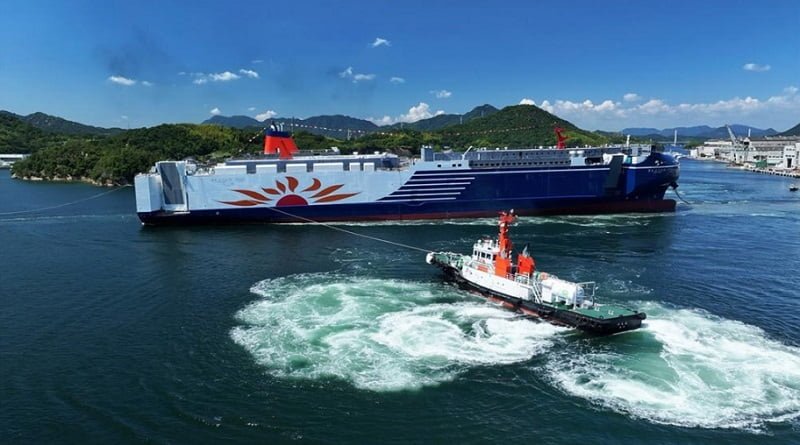Mitsui O.S.K. Lines, Ltd. (MOL) held the naming and launching ceremony for the LNG-fueled ferry Sunflower Pirka on September 4. The ceremony, marking a significant milestone in sustainable maritime transportation, took place at the Naikai Zosen Corporation shipyard in Onomichi, Hiroshima Prefecture. The ferry, built by MOL and its group company, MOL Sunflower Ltd., is designed for the Oarai-Tomakomai route, one of Japan’s key ferry services connecting the Kanto and Hokkaido regions.
During the event, the LNG-fueled tugboat Ishin, operated by MOL Group company Nihon Tug-Boat Co., Ltd., assisted in the ferry’s launch operations, underscoring MOL’s commitment to sustainable fuel practices. The Ishin, a pioneer among LNG-fueled tugboats, symbolizes the next phase of MOL’s journey toward adopting clean energy solutions.
A Shift Toward Low-Carbon Shipping
MOL’s move to integrate LNG as a practical low-carbon fuel is part of its broader strategy to lead the industry toward decarbonization. The Sunflower Pirka, expected to be delivered in April 2025, will enhance the fleet of LNG-powered vessels. It will operate alongside the Sunflower Kamuy, scheduled to enter service in early 2025 on the Oarai-Tomakomai route, joining the already operational Sunflower Kurenai and Sunflower Murasaki on the Osaka-Beppu route since 2023.
Once launched, the Sunflower Pirka will be MOL’s fourth LNG-powered ferry, contributing to the company’s extensive service network. MOL Sunflower currently operates 10 ferries and 5 RORO vessels across 6 routes, making it Japan’s largest ferry operator in terms of fleet size and network reach. The new vessel will further solidify the group’s leadership in providing reliable passenger and logistics services, while significantly reducing carbon emissions.
Naming Ceremony Honors Tradition
The ferry’s name, Sunflower Pirka, was chosen by Sueji Shinohara, chairman of the Hokuren Federation of Agricultural Cooperatives. His wife performed the ceremonial rope-cutting, officially naming the vessel. The name “Pirka,” derived from the Ainu language, translates to “beautiful,” “nice,” and “rich.” It symbolizes a connection to Hokkaido’s heritage and the ferry’s role in linking communities while promoting a brighter, more sustainable future.
While the Sunflower Kamuy and Sunflower Pirka share the same hull design, each vessel will feature distinct interior designs, offering passengers a unique experience and heightened anticipation for their journey.
Performance and Environmental Benefits
The Sunflower Pirka is equipped with cutting-edge technology aimed at reducing its environmental impact. The ferry is expected to cut CO2 emissions by approximately 35% compared to existing vessels on the Hokkaido route. This achievement is made possible through the adoption of the Ishin hull form, which harnesses oblique headwinds for propulsion, as well as energy-saving devices developed by Naikai Zosen. The ship will also be fitted with high-performance LNG-fueled engines, further enhancing its environmental performance.
In addition to supporting Japan’s Modal Shift initiative, which promotes the use of ferries to reduce long-haul trucking, the new ferry addresses the “2024 logistics problem” by offering more space for trucks and providing private cabins for truck drivers, improving both comfort and logistics efficiency.
Role of LNG-Fueled Tugboat Ishin
The tugboat Ishin, delivered in February 2019 and owned by MOL, played a pivotal role in the Sunflower Pirka’s launch. As Japan’s first LNG-fueled tugboat, Ishin has served as a model for subsequent LNG-fueled vessels in MOL’s fleet. Its participation in the launch ceremony symbolized the transfer of accumulated expertise in LNG fuel technology to the next generation of vessels, reinforcing MOL’s leadership in this field.
Commitment to Decarbonization
MOL is committed to achieving net zero greenhouse gas (GHG) emissions by 2050, in line with its MOL Group Environmental Vision 2.2. The company will continue to pursue the adoption of clean alternative fuels and lead the charge toward decarbonization within the maritime industry. While LNG remains a key component of MOL’s strategy, the company is actively researching other fuels to further enhance its environmental initiatives.
MOL’s proactive approach in adopting LNG-powered ships, such as the Sunflower Pirka, demonstrates its leadership in creating a low-carbon, sustainable future for the maritime industry.
About Sunflower Pirka
Origin of the Name: The name Pirka pays homage to the Ainu people, indigenous to northern Japan, especially Hokkaido, where the ferry will operate. The word “Pirka” embodies beauty and richness, symbolizing the ferry’s role in connecting communities and fostering a prosperous future.
Performance: The Sunflower Pirka will contribute to a 35% reduction in CO2 emissions, using advanced technologies such as the Ishin hull form and energy-saving devices. It also offers more space for logistics and greater comfort for drivers with private cabins.
About the LNG-Fueled Tugboat Ishin
Owned by MOL and operated by Nihon Tug-Boat Co., Ltd., Ishin has set the standard for LNG-fueled vessels since its launch in 2019. Its role in the Sunflower Pirka’s launching ceremony highlights the passing of technological expertise to MOL’s next generation of LNG-powered vessels.
MOL’s continued investment in clean fuel alternatives places it at the forefront of decarbonization efforts within the maritime industry, ensuring a sustainable future for coastal and international shipping.
Source Mol Group

